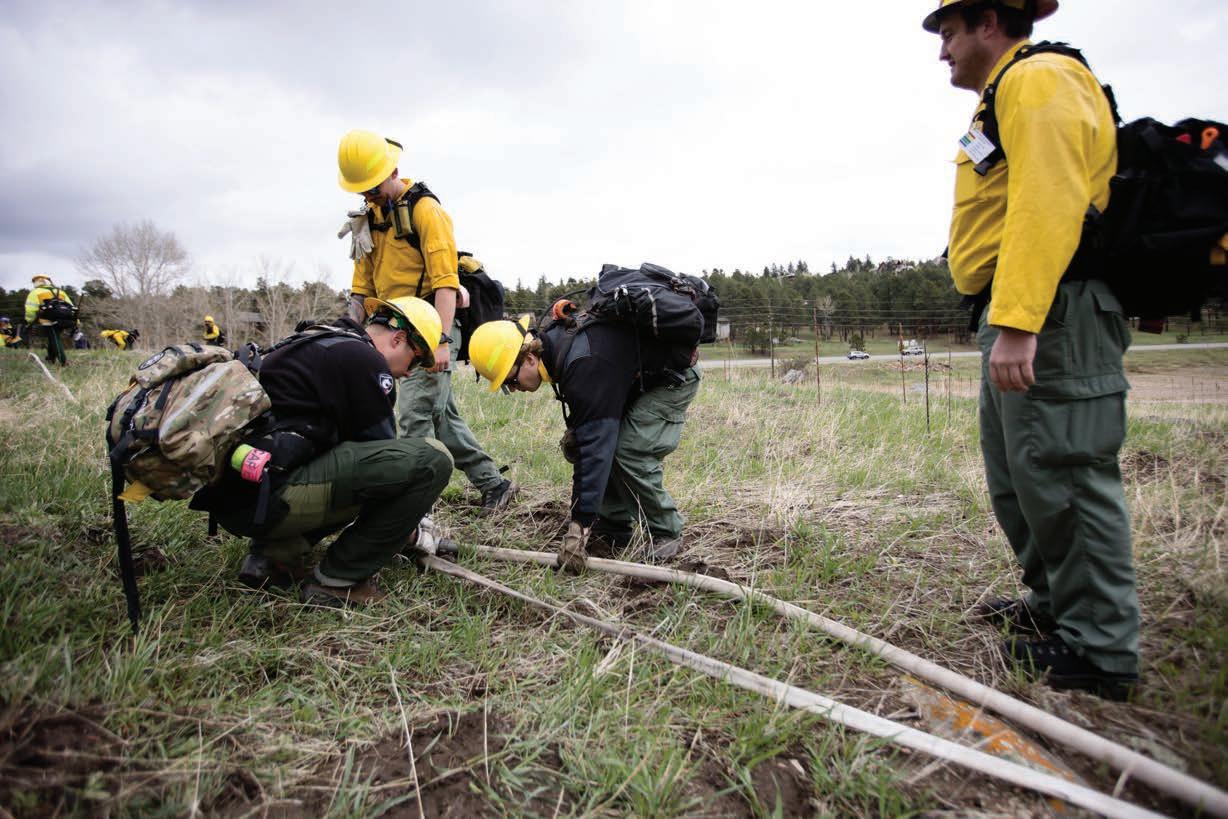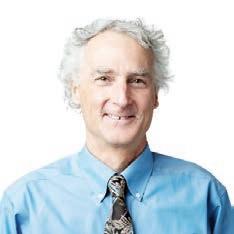
4 minute read
Working together to fight wildland fires
Evergreen Fire/Rescue hosts training for six entities
BY DEB HURLEY BROBST DBROBST@COLORADOCOMMUNITYMEDIA.COM








e phrase “It takes a village” is true in re ghting, especially when it comes to attacking wild res.

About 80 re ghters from multiple agencies learned more about working together and wild re- ghting techniques during an all-day training hosted by Evergreen Fire Rescue on May 13. Joining EFR were Clear Creek, Genesee, Foothills and Indian Hills re departments plus the Highland Rescue Team and Je co Open Space.
It’s important that re departments have established a rapport and know how to communicate especially since departments request mutual aid if res grow, according to Einar Jensen, a spokesman for Evergreen Fire/Rescue.

“ is is a great opportunity to do mountain training, especially up here,” Capt. Dan Noell with the Clear Creek Fire Authority said. “ ese are the departments who are going to respond.” e re ghters moved through three training sites: laying hoses to ght a wild re, digging lines around a wild re and assessing structures to determine whether they could survive a wild re.
Foothills Fire Chief Rod Cameron said the face-to-face training was bene cial, so re ghters know each other and are familiar with di erent departments’ routines.

Since teamwork was the goal of the day, the three groups of re ghters had representatives from all of the departments, so they worked together on the tasks. ere were no actual ames involved in the training. Nonetheless, re ghters imagined how they would react if a wild re was moving in their direction.

Laying hoses
Fire crews practiced laying hoses in Elk Meadow and running the pumps necessary to get water to

Oliver Stone has a new movie, “Nuclear Now,” that made its Colorado debut in Boulder on May 1. In it, Stone argues that the grave risks posed by climate change require we embrace nuclear energy.
A few hours before, at a hearing in Denver, state legislators heard an even more urgent equation. “Anybody who opposes nuclear I believe is a climate denier,” an individual testi ed before the Senate Transportation and Energy Committee.

And in Pueblo that evening, city council members heard about a committee formed by Xcel Energy to study options to replace tax base, jobs, and electrical generation once the last coal plant there closes. e group will hear about nuclear.
In the background is the federal government, o ering gambling money on all sorts of decarbonization solutions, including nuclear.
People on the left and right nd common ground in support of nuclear energy, but their motivations di er. Some, like Stone, the movie-maker, are driven by the existential danger posed by climate change. Even the pleasant days of spring are spoiled by news that the carbon dioxide detector atop Mauna Loa recently rolled past 425 parts per million, up from 315 ppm in the 1950s. We’re dancing ever farther on the snow cornice, ddling with our phones in busy tra c. We’re irting with real danger here.
Some in Colorado see nuclear energy replacing coal plants. e last coal unit at Pueblo will close no later than 2031. Xcel has guaranteed property tax revenues through 2040, but not to 2070, the original retirement date. Craig also faces giant uncertainties. Increased tourism?
“We don’t want to become sheetchangers,” one Mo at County landowner told me.
Western Montrose County, where a uranium boom occurred during the 1950s — and which lost a small coal plant in 2019, is also interested in nuclear.
HB23-1247, titled “Assess Advanced Energy Solutions in Colorado,” now awaiting the governor’s signature, will direct study of nuclear energy but also other options. All have upsides but questions marks. Green hydrogen, made from renewables and water, can store energy for use when renewables are unavailable. However, the technology remains costly. Too, some scientists question whether accidental release of hydrogen into the atmosphere will create as many problems as it solves.
Nuclear can also backup intermittent renewables. Nuclear does provide 20% of U.S. electricity. We have a eet of nuclear-powered submarines. ey seem to operate without problems. But some questions remain about nuclear safety. Would you want a large-scale reactor in your town or city? I have to also wonder about nuclear technology falling into the wrong hands. at sounds appealing, but by denition that model will not replace the big coal plants at Pueblo and Craig. For that matter, it does not yet exist.
Many have been closely following the progress in Wyoming of a nuclear plant planned next to a coal plant at Kemmerer. TerraPower, the company founded by Bill Gates in 2008, says it will require less water and produce less nuclear fuel waste while plugging nicely into old coal plants. It projects cost of $4 billion for this plant that will use Natrium technology.
WyoFile reported that while in Kemmerer during early May, Gates called it a “pioneering move,” key to the global energy future. is project is projected to be ready in in 2030. Paci Corp, a major regional power provider, has said it could add ve more such Natrium reactors at existing coal- red plants in Wyoming and Utah.
Another potential model is assembly-line-style production of small modular reactors, lowering costs.
Here in Colorado, I hear people with degrees in nuclear engineering express doubts about nuclear. State
Sen. Chris Hansen, at the recent legislative hearing, objected to how a witness had characterized his skepticism about nuclear. “It has nothing to do with science or technology,” said Hansen, who has a degree in nuclear engineering. “It’s the cost pro le.” He cited a recent Georgia reactor that came in at $33 billion, three times the projected cost. It’s not the only example.
Chuck Kutscher got his master’s degree in nuclear engineering and worked in the nuclear sector California before turning his attention to solar in 1978 and moving to Colorado. “New nuclear power plants, including new U.S. reactor technologies currently under development, will likely be too expensive and take too long to build to make a signicant contribution to climate change mitigation,” he says.
In Boulder, Oliver Stone’s movie talked little of costs. But in Pueblo, a representative of Idaho National Laboratory, speaking to a municipal energy study group, openly conceded that cost remains the million dollar question.
She misplaced a comma or two in that string of zeroes, though. It’s the billion dollar question. Many billions.
Allen Best publishes Big Pivots, which chronicles the energy and water transitions in Colorado and beyond. Subscriptions are free at bigpivots.com; donations are welcomed.










